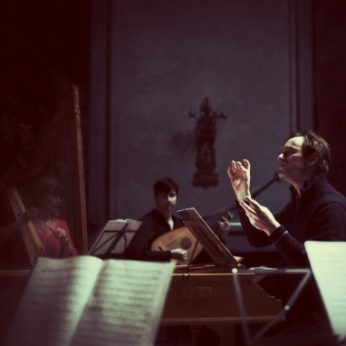Composer: Georg Philipp Telemann (b. 1681 - d. 1767)
Performance date: 27/06/2015
Venue: St. Brendan’s Church
Composition Year: 1733
Duration: 00:09:00
Recording Engineer: Richard McCullough, RTÉ lyric fm
Instrumentation Category:Small Mixed Ensemble
Instrumentation Other: 2vn, va, vc, db, lu, hpd
Artists:
Arcangelo (Sophie Gent, James Toll [violins], Rebecca Jones [viola], Sarah McMahon [cello], Tim Amherst [bass], David Miller [lute], Jonathan Cohen [harpsichord,director]) -
[baroque ensemble]

Born in Magdeburg, Germany on March 14, 1681, Telemann
died at the considerable age of 86 on June
25, 1767 after having spent 56 years in Hamburg. He was considered one of the
leading German composers of the time, comparable with both Johann Sebastian Bach and George Frideric
Handel. Unlike Bach, who never broke away from his native region of Saxony and
Thuringia, Telemann was a cosmopolitan, drawn towards musical centres like
Paris, London, Lisbon and St. Petersberg. His career was one of the longest and
most prolific in music history and for over forty years he dominated the
bustling music scene in Hamburg. His compositional style rarely exhibits an
indepentant streak and accomodates itself to every occasion. From solemn church
anthems to rambunctious theater piece, cantatas, concertos, sinfonias and
sonatas, his music was aimed at reapping the applause of his contempories
rather than creating confusion. Despite this immense output, Telemann was not
simply a music machine churning out work after work, following the rules was
not a trait associated with him and therefore he rarely strayed far from the
forefront of contemporary development. Characteristic of Telemann’s style of
writing is taking already existing elements and putting them in new contexts,
consequently his works document a gradual progression from the Baroque to
Classical Style.
The first movement of Sinfonia
Spirituosa in D major fuses the revered Baroque chacconne model with
contrasting sections in such a way as to insinuate the sonata form of the
Classical era. The Largo is in a light aria
style of then in vogue opera house, filled with only three contrasting yet
elegantly complementary ideas. The work is concluded by an upbeat dance-like
finale with rhythmic gestures reminiscent of Neopolitan masters such as
Pergolesi and Durante.
Copyright © 2025 West Cork Music. All rights reserved.
Designed and developed by Matrix Internet